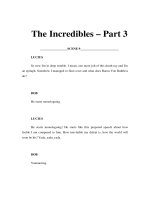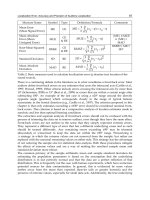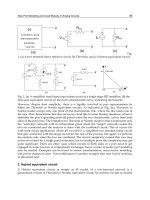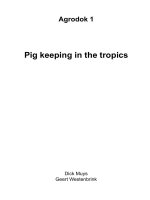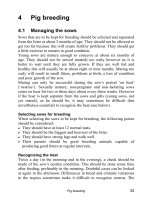The vegetable garden in the tropics - Part 3 ppt
Bạn đang xem bản rút gọn của tài liệu. Xem và tải ngay bản đầy đủ của tài liệu tại đây (298.12 KB, 17 trang )
The vegetable garden in the tropics 18
5 Preparing the site
5.1 The best site for a garden
The best sites for a garden are located:
1 Near a water supply (well, stream, pool). In the dry season the crop
needs watering. Sometimes you may have to have two gardens, one
for the dry season, located near a well or by the side of a lake or pool,
and one for the rainy season on a flat site that does not flood.
2 On flat or only slightly sloping ground. On steep slopes terraces have
to be made to prevent erosion. If you have a terraced garden take care
that the top layer, which is the most fertile, stays on the surface.
3 Near the house, so carry-
ing supplies and guard-
ing the garden are easier.
4 On a loose and perme-
able soil that is rich in
organic matter. Avoid
stony or very clayish
soils, which crack deeply
when they dry out, and
very sandy soils. Sites
with poor (sandy) soil
can be suitable if im-
proved with manure or
compost (see Chapter 6).
5 In a sunny place, well sheltered from the prevailing winds.
6 On ground with few weeds that have underground stems, such as Im-
perata (satin tail), or small tubers like Cyperus. Ground covered with
these weeds is difficult to clear and keep weed-free.
Generally, newly cleared forest soil, rich in humus, light non-flooded
soil in valleys and soil where humus and eroded matter have accumu-
lated, are suitable.
If you have no choice, you will probably have to improve less suitable
ground.
Figure 3: Avoid stoney soils!
Preparing the site 19
5.2 Size and design of the garden
Regarding the size, you must remember that a small, well tended garden
gives better results than a larger but poorly maintained one.
The size of the garden should be calculated according to:
? the amount of vegetables needed for family use and for the market.
? time, water and fertilizer available.
In a family garden, approximate yields to be expected are:
? leaf vegetables: 8kg/m
2
/year
? fruit vegetables: 10kg/m
2
/year
? fruit (fruit trees): 2kg/m
2
/year
Figure 4: The lay-out of a garden
Therefore, for a family of six people, where each member consumes
50g leaf vegetables, 100g fruit vegetables and 50g fruit a day, a surface
of 100 m
2
would be sufficient. If you also want dried beans
(0.4kg/m
2
/year) and tubers (8kg/m
2
/year) from your garden, you will
The vegetable garden in the tropics 20
need a much larger site. You will have to add surface for the paths and
for a compost heap. It is good to make a drawing of the layout of the
garden on which you can also indicate crop rotation (see Chapters 6 and
8). Figure 4 is an example of such a plan, although it is not necessary
for every garden to be so “orderly”. Most important is that you place the
nursery beds near the water supply and the compost heap far away from
the water supply, so the water does not become polluted by infiltration,
especially if you use the water supply for drinking water.
5.3 Clearing the site
You will have to start by clearing the covering vegetation from the site
of your future garden. Clearing is necessary because:
1 Trees, shrubs and weeds draw water and minerals from the soil that
are needed for the vegetables.
2 The shade caused by their leaves hinders crop development.
3 They shelter insects.
Figure 5: This tree hinders crop development. Why?
Shrubs and trees must be completely removed. If it is not too difficult,
tree roots should also be removed. Cut trees and shrubs provide sticks
of all sizes that are always useful (e.g. for fences, stakes), wood for con-
Preparing the site 21
struction and firewood. Waste wood should be burned and the ashes
thrown on the compost heap. Other waste material can be put directly
into the compost heap. Dead and dry material can be used for soil cover
(see Chapter 8). Remove stones and larger pebbles. It is worth keeping a
few trees to provide shade for a small cattle pen, the compost heap and
the nursery.
5.4 Cultivating the soil
Why cultivate the soil?
? Newly cleared soil is often hard and compact, especially when it is
clayey. Air and rain water can not penetrate and it is covered with
weeds. These are some of the reasons for tilling the soil:
? loosening the soil aids root penetration and growth.
? aerating the soil and making it permeable for water.
? working in organic matter and weeds, that form fertile humus.
When should you cultivate the soil?
? A light (sandy) soil can be cultivated at any time. A heavy (clayish)
soil should be neither too dry nor too wet.
? A soil that is too dry can be too hard for the tools to penetrate and you
get big clods, which are difficult to break up.
? A soil that is too wet sticks to the tools and you risk destroying the
structure of the soil.
How deep should you till?
? For a successful tillage it is necessary to know something about the
vertical build-up of the soil. In general, a soil profile has three layers:
? a surface horizon (topsoil), containing some humus (remains from
plant debris, see Chapter 6). This layer is usually slightly darker col-
oured and is the most fertile part of the soil.
? a subsurface horizon (subsoil), containing less or no humus, some-
times heavier than the overlying and underlying layers.
? the more or less unweathered parent material from which the over-
lying layers have developed. This layer is much less fertile and usu-
ally lighter than the topsoil.
The vegetable garden in the tropics 22
Most of the roots of vegetables concentrate in the topsoil and, to a lesser
extent, in the subsoil, but there are differences between vegetables. Pi-
geon pea roots, for example, grow much deeper than those of lettuce.
Soil tillage should not change the relative position of the soil layers: the
fertile top layer should stay on top and each layer should stay in place as
much as possible.
The first tillage of the soil, especially if the soil is compact after clear-
ing, should be done two spits deep, to at least 30cm. Work with an open
furrow. At the bottom you turn the spadeful, and on top of that you
throw the first spadeful from the next furrow etc. When working with a
hoe you also work with an open furrow. Remove the earth from a nar-
row strip, loosen the bottom layer and cover it up again with the earth of
the top layer from the next strip, and so on.
Figure 6: A soil profile
Deep tillage is especially recommended for soils that are compact and
less permeable (often clayish soils). For normal maintenance, a depth of
one spit will do (see fig. 7). After several tillages (while working under
manure) the layer of topsoil, suitable for cultivation will become thicker
and looser.
Preparing the site 23
Figure 7: Hoeing and spading
5.5 Preparing the beds
The beds are the parts of the garden where the crops themselves are
grown. The division of the garden into beds makes crop rotation possi-
ble.
Erosion prevention
On steep sloping ground the beds should be made across the slope, so
that they are horizontal. By digging trenches around each bed, you pre-
vent the earth from being washed away by rainwater.
Size
The beds should not be more than 1.2m wide, so that the gardener can
easily reach the middle without having to walk on the plants. Main
paths should be at least 60cm wide (to enable a wheelbarrow to pass),
and footpaths should be 30-40cm wide (the size of a foot).
Level
In the dry season or on sandy soil you make flat beds with raised edges
of 5-10cm, so that the water does not flow off to the sides. In the rainy
season, or on clayish soils you should make beds with a level of up to
The vegetable garden in the tropics 24
20cm, with a slightly rounded form: enough to let the surplus water
flow away, but not enough to let the earth be washed away. In the rainy
season it is sometimes useful to put stones, bamboo sticks or plaited
palm leaves around the edge of the beds to prevent erosion.
Figure 8: Different beds
It should be noted here that in several countries vegetables are grown on
ridges. This is especially suitable for the cultivation of big plants such
as maize, eggplant and melon, and on soils with poor drainage.
5.6 Fences
It is worth making fences to protect your crops against animals and the
wind. You can make a fence from solid sticks, live stakes (see below),
thorny branches, palm leaf-stalks, bamboo or barbed wire (expensive!).
It might be a good idea to enclose the garden with branches to keep the
vegetables out of sight of hungry animals.
If you want to plant a live hedge, use some of the following plants
spaced close together:
? shrubs and trees, such as the drumstick tree, which has edible leaves
and of which you plant 1m high cuttings.
? sisal, which gives very good protection and is suitable for the sa-
vanna; plant bulbils in double zigzag rows, about 50cm apart.
Preparing the site 25
? a cassava hedge provides edible leaves. Cuttings must be planted 5-
10cm apart or in double zigzag rows, 20cm apart. For a dense hedge,
the plants must be trimmed and strengthened with sticks or bamboo.
This kind of hedge gives good protection.
? pigeon pea, a leguminous perennial shrub, gives poor protection, but
provides edible beans and fodder for small stock.
? a hedge consisting of stakes or live trees (drumstick tree, mimosa) in
combination with climbing vegetables (passion flower, Ceylon spin-
ach, beans, gourds, chayote) gives poor protection.
? ornamental plants, such as croton, bixa and bougainvillea give
fairly good protection after a few years of growth.
The vegetable garden in the tropics 26
6 Soil improvement
Plants must receive sufficient nutrients in order to grow properly.
? The leaves absorb oxygen and carbon dioxide from the air. They pro-
duce the constituents of the plant: carbohydrates, proteins etc.
? The roots draw up water and other vital elements from the soil. Ni-
trogen, phosphate and potassium are the most important of these.
They are found in the soil as mineral salts and in humus.
The gardener must improve the soil in his or her garden by adding nu-
trient elements to replace the elements lost by harvesting the vegetables
or erosion, and to enrich the soil. There are 4 ways of doing this: soil
conditioning, organic manuring (dung), chemical fertilizer and crop ro-
tation.
6.1 Soil conditioning
Conditioning a soil means modifying its physical state by changing its
texture, permeability and humidity. The soil is composed of clay (very
small particles), sand (coarser particles) and humus (partially decom-
posed organic matter). The best proportions of these components for
farmland are approximately: 20-30% clay, 65-75% sand and 5% humus.
A soil that contains too much clay is heavy and compact, impermeable
to water and air, very hard when dry and sticky when wet. Such a soil is
difficult to cultivate. Adding sand or humus makes it lighter. On the
other hand, a soil that is too sandy is light and easy to cultivate, but
dries out quickly and does not retain nutrients. Adding organic matter is
the most important improvement you can make. By applying organic
manure you improve the physical state of the soil by increasing the
amount of humus and by adding nutrients which your crops need.
6.2 Plant nutrients
Plants need nutrient elements for their growth. We distinguish principle
elements (nitrogen, phosphorus, potassium) which are needed most of-
Soil improvement 27
ten, and in the largest quantities, and secondary elements (calcium,
magnesium, sulphur) which are needed in small or very small quanti-
ties. Besides these there are minor elements (iron, copper, zinc, manga-
nese, boron, chlorine, molybdenum) which are needed only in minimal
amounts. These elements are present in the soil in the form of mineral
salts. They are absorbed by the roots. A soil is fertile when it has a high
content of nutrient elements and when it has a high retention capacity,
that is to say that it retains many of these elements in a form which
plants can easily take up. Generally, clay soils are more fertile than
sandy soils. A soil rich in humus has a high retention capacity for nutri-
ent elements. The amount of nutrient elements in a soil is increased by
adding fertilizer. The added elements remain available to the plants for a
long time if the retention capacity of the soil is high; if not, they are
quickly lost.
Figure 9: The main elements necessary for the crops in a vegeta-
ble garden
1 Nitrogen, represented by the symbol N, is needed for plant growth,
especially of the stems and leaves. It gives the leaves a dark green
colour. Vegetables grown especially for their leaves (amaranth, let-
The vegetable garden in the tropics 28
tuce)need large amounts of nitrogen. Beds on which you want to
grow tomato, eggplant or carrots shouldn’t get too much N because
this would favourgrowth of the leaves, instead of the roots and fruits.
Signs of deficiencyare: small and deformed plants, particularly small,
light or yellowish green leaves and premature browning of the bot-
tom leaves, while the top of the plant stays green.
2 Phosphorus
, (phosphate), represented by the symbol P, is necessary to
formseeds and flowers, and to increase disease resistance. It is
needed especially for seed and fruit vegetables (tomatoes, pepper,
okra, beans) and for root vegetables (carrots). Signs of deficiency are:
stunted growth, light green leaves often purple or brown at the tips
and edges, slow and often etiolated development, and few fruits and
seeds.
3 Potassium
, represented by the symbol K, stimulates development of
rootvegetables (carrots, radish, cassava) and tubers (sweet potato, po-
tato) and is also important for onions and tomatoes. Potassium helps
the plant to resist drought and diseases. Signs of deficiency are: white
yellowish or reddish spots on the leaves, starting at the leaf edges
(especially of the lower leaves), which turn yellow, red or brown and
finally dry out and die, and stunted growth.
6.3 Organic manure
Organic manure provides the soil with humus and all the nutrient ele-
ments necessary for plant growth. The humus makes the soil easier to
cultivate and increases its permeability and its retention capacity for
water and nutrients. Organic manures are: dung, compost, litter and
green manure. The necessary amount of green manure is at least 1kg per
kg harvested vegetables or 2.5kg anure per square metre, to be worked
in before each sowing.
Dung
Dung is obtained by fermentation of faeces and litter of animals. It
makes the soil very fertile. Some animals give better dung than others
(in decreasing order: poultry, horses, sheep and goats, cattle, pigs). To
get good dung, the bedding of the animals must be abundant and re-
Soil improvement 29
newed often enough to be able to absorb the droppings and to keep the
manure heap humid. The earth under the heap should be well tamped or
even cemented to avoid losses by leaching. Before cultivating a plant
bed, spread the dung evenly over the surface and then begin to work it
under. Ideally, the soil should be prepared like this and tilled one or two
weeks before sowing or planting, so the dung has had time to decom-
pose a little. You can also use a solution of liquid manure or dung in
water: mix a few litres of liquid manure or a few handfuls of dung for a
bucket of water of about 10 litres. Sprinkle the soil with this solution,
not the plants.
Compost
Compost is obtained by decomposition of a mixture of vegetable waste
matter, household waste or street sweepings from the city (anything that
cannot decompose should be removed: cans, plastics etc.), cooled ashes,
sweepings, weeds, leaves, straw, groundnut or cotton cake etc. Com-
posting is done in pits (in a dry climate) or heaps (in a humid climate).
Compost heaps require less work than pits. Fig. 10 explains the classic
process of preparing compost as it is done in temperate climates. The
process is the same, whether it is for a “pit” or a “heap”.
Figure 10: How to make good compost
The vegetable garden in the tropics 30
1 Dig three pits of about 1.5 x 1.5m, side by side (or make three heaps
and so on).
2 In the first pit you put a mixture of the above mentioned waste, on
top of which you put earth and/or dung to stimulate decomposition.
Cut big objects (such as banana tree trunks, maize stalks) into smaller
pieces.
Burn woody wastes which do not decompose and diseased or insect
infested plants, and put the ashes on the compost heap. The contents
of the pit should be humid but not too wet, to decompose well. Water
or shelter the pit as necessary.
3 After a month fill pit number 2 with the contents of pit number 1.
Mix in water and pack the pit well. Cover it with a layer of earth,
which you stamp down and water from time to time. When pit num-
ber 1 is empty, you can fill it up again with new waste.
4 After another month fill pit number 3 with the contents of pit number
2 and air it well. Cover it with a little earth and branches to protect it
from evaporation and rain, but do not pack it. Fill pit number 2 with
the contents of pit number 1 and refill pit number 1 with new waste.
5 At the end of the third month you can empty pit number 3 and use the
compost. Continue in the same way, emptying and refilling the pits.
Work the compost into the soil in the same way as manure. Compost-
ing has the advantage that plant and human diseases are killed by the
high temperatures during the composting. Agrodok 8 describes in de-
tail how to make and use compost.
City street sweepings and fresh household waste
These and all other materials that decompose easily can also be worked
in directly without composting. In a tropical climate organic matter de-
composes quickly and therefore it is not always necessary to compost.
Sometimes it is too much work and the chances of loss of nutrient ele-
ments are higher. Our advice is to work in directly all material that is
easily broken down (fine, not woody, leaves etc.) and to compost only
those materials that take longer to decompose. If there is danger of con-
tagious disease simply compress the waste or the sweepings for one or
two weeks before working them in. This should be enough to kill most
Soil improvement 31
microbes. A simple way to use household waste is to fill up a hole with
it and plant a banana shoot in it. (Remove cans, plastics etc.)
Mulching
This is done by covering the seed and planting beds and the soil around
the plants with a layer of straw, long straw manure, maize stalks etc.
After a certain amount of time the straw rots and becomes humus. Fig.
11 shows also the other effects of covering the soil.
NB The cover should never touch the plant stems as this can cause
rot. In some cases the cover can attract termites. You should never cover
with material that is infected by disease or contains insects.
Figure 11: The effects of soil covering
Green manure
This consists of plants that are worked in to enrich the soil. The leaves
and stems of legumes such as beans and peanuts are excellent, as they
are rich in nitrogen. The roots of legumes can fix the free nitrogen pre-
sent in the soil.
The vegetable garden in the tropics 32
6.4 Chemical fertilizers
Chemical (or mineral) fertilizers are powders or granules that contain
nutrient elements. They do not provide humus. When sufficient organic
manure is available, a family garden generally does not need any
chemical fertilizers. These fertilizers are expensive and it is better to
consult an agricultural adviser before using them. Below are a few im-
portant points about fertilizers.
1 Straight fertilizers contain only one nutrient element, for example
N, P or K. The most important ones are the nitrogenous fertilizers (ni-
trates, ammonium sulphate); phosphates and superphosphate; potas-
sium chloride and potassium sulphate. The sulphate fertilizers also
contain sulphur.
2 Compound fertilizers contain at least two fertilizing agents. One
such fertilizer, much used in commercial vegetable growing, is the
so-called 10-20-20 (fig. 12), a fertilizer containing 10kg nitrogen (N),
10kg phosphate (P) and 20kg potassium (K) per 100kg. The order of
notation N-P-K is always the same. A bag of 50kg of fertilizer con-
tains 5kg nitrogen, 5kg phosphate and 10kg potassium. A normal
dosage of this fertilizer - for a not very intensive cultivation - is 20-
50g per m
2
per crop.
Figure 12: Label for a fertilizer bag
3 Secondary elements can be provided by ashes, rich in calcium, mag-
nesium and potassium. Calcium (lime, limestone) makes the soil less
Soil improvement 33
acid. N and K fertilizers in the form of sulphates contain sufficient
sulphur. Thomas slag contains all trace elements, as well as phos-
phoric acid.
4 In a tropical climate it is better to apply small quantities of fertilizer
often, rather than to add a large quantity in one treatment. This makes
the fertilizers more profitable and prevents too rapid growth. Nor-
mally, fertilizers are applied shortly before sowing or transplanting.
Nitrogen fertilizers can be partially applied while the crop is growing.
5 Most often the fertilizer is spread by hand and then worked under by
superficial cultivation with a hoe. Sometimes the fertilizer is applied
in lines or strips next to the plants, or next to or under the seeds. The
fertilizer should not come in contact with leaves or buds as it will
burn them.
6 Chemical fertilizers are expensive and should be kept in a dry place
to avoid hardening or loss.
6.5 Crop rotation
Crop rotation is the practice of growing a sequence of different vegeta-
bles on the same bed. If you grow the same vegetable several consecu-
tive times on the same bed you get lower and lower yields. By alternat-
ing the crops the beds continue to give high yields. Crop rotation is nec-
essary for three reasons.
1 Different vegetables have different insect pests, diseases and nema-
todes.
If you grow the same vegetables, or vegetables from the same family
(see Chapters 8 and 9) several times in succession, you encourage the
multiplication of insects, nematodes and diseases common to this
vegetable or group of vegetables. If you vary the vegetables, you
lessen this problem.
2 Vegetables differ in their nutrient requirements. As mentioned above,
leaf vegetables have high nitrogen requirements, while seed and fruit
vegetables need more phosphate. Plants grown for their tubers or
roots need more potassium. If, for example, you grow beans several
times after each other on the same bed, phosphate reserves run out
and yields get lower. But if you plant cassava after the beans, which
The vegetable garden in the tropics 34
needs the nitrogen with which the beans (legumes!) have enriched the
soil, the cassava grows well and the soil can build up new phosphate
reserves.
3 Different vegetables take up nutrients from different depths. Some
plants, such as lettuce, have very shallow roots and take up nutrients
from near the soil surface. Others, such as okra, tomato and beans,
have deeper roots and obtain their nutrients from deeper layers of the
soil.
If sufficient organic manure is available only the first point is important,
but that is, however, the most important reason for crop rotation. You
should therefore grow consecutively in the same beds vegetables that
have different parasites and insects. You should grow simultaneously
but in different beds a variety of vegetables. This is better for your diet
and the market as well. For crop rotation see also Chapters 8 and 9.
